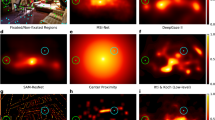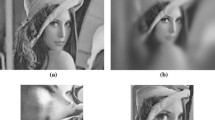Abstract
A saliency map is the bottom-up contribution to the deployment of exogenous attention. It, as well as its underlying neural mechanism, is hard to identify because of the influence of top-down signals. A recent study showed that neural activities in V1 could create a bottom-up saliency map (Zhang et al. in Neuron 73(1):183–192, 2012). In this paper, we tested whether their conclusion can generalize to complex natural scenes. In order to avoid top-down influences, each image was presented with a low contrast for only 50 ms and was followed by a high contrast mask, which rendered the whole image invisible to participants (confirmed by a forced-choice test). The Posner cueing paradigm was adopted to measure the spatial cueing effect (i.e., saliency) by an orientation discrimination task. A positive cueing effect was found, and the magnitude of the cueing effect was consistent with the saliency prediction of a computational saliency model. In a following fMRI experiment, we used the same masked natural scenes as stimuli and measured BOLD signals responding to the predicted salient region (relative to the background). We found that the BOLD signal in V1, but not in other cortical areas, could well predict the cueing effect. These results suggest that the bottom-up saliency map of natural scenes could be created in V1, providing further evidence for the V1 saliency theory (Li in Trends Cogn Sci 6(1):9–16, 2002).





Similar content being viewed by others
References
Asplund CL, Todd JJ, Snyder AP, Marois R (2010) A central role for the lateral prefrontal cortex in goal-directed and stimulus-driven attention. Nat Neurosci 13(4):507–514
Baluch F, Itti L (2011) Mechanisms of top-down attention. Trends Neurosci 34(4):210–224
Berman RA, Colby CL, Genovese CR, Voyvodic JT, Luna B, Thulborn KR, Sweeney JA (1999) Cortical networks subserving pursuit and saccadic eye movements in humans: an FMRI study. Hum Brain Mapp 8(4):209–225
Betz T, Wilming N, Bogler C, Haynes J, Konig P (2013) Dissociation between saliency signals and activity in early visual cortex. J Vis 13(14):1–12
Bogler C, Bode S, Haynes J (2011) Decoding successive computational stages of saliency processing. Curr Biol 21(19):1667–1671
Bruce N, Tsotsos J (2005) Saliency based on information maximization. NIPS 18:155–162
Buracas GT, Boynton GM (2002) Efficient design of event-related fMRI experiments using M-sequences. Neuroimage 16(3):801–813
Buschman TJ, Miller EK (2007) Top-down versus bottom-up control of attention in prefrontal and posterior parietal cortices. Science 315(5820):1860–1862
Carrasco M (2011) Visual attention: the past 25 years. Vis Res 51(13):1484–1525
Chen W, Zhu XH, Thulborn KR, Ugurbil K (1999) Retinotopic mapping of lateral geniculate nucleus in humans using functional magnetic resonance imaging. Proc Natl Acad Sci USA 96(5):2430–2434
Connolly JD, Goodale MA, Menon RS, Munoz DP (2002) Human fMRI evidence for the neural correlates of preparatory set. Nat Neurosci 5(12):1345–1352
Corbetta M, Shulman GL (2002) Control of goal-directed and stimulus-driven attention in the brain. Nat Rev Neurosci 3(3):201–215
Dehaene S, Naccache L, Le Clec’H G, Koechlin E, Mueller M, Dehaene-Lambertz G, Van de Moortele PF, Le Bihan D (1998) Imaging unconscious semantic priming. Nature 395(6702):597–600
Del Cul A, Baillet S, Dehaene S (2007) Brain dynamics underlying the nonlinear threshold for access to consciousness. PLoS Biol 5(10):e260
Engel SA, Glover GH, Wandell BA (1997) Retinotopic organization in human visual cortex and the spatial precision of functional MRI. Cereb Cortex 7(2):181–192
Fecteau JH, Munoz DP (2006) Salience, relevance, and firing: a priority map for target selection. Trends Cogn Sci 10(8):382–390
Fei-Fei L, Fergus R, Perona P (2004) Learning generative visual models from few training examples: an incremental Bayesian approach tested on 101 object categories. In: IEEE CVPR, workshop on generative-model based vision
Geng JJ, Mangun GR (2009) Anterior intraparietal sulcus is sensitive to bottom-up attention driven by stimulus salience. J Cogn Neurosci 21(8):1584–1601
Gilbert CD, Li W (2013) Top-down influences on visual processing. Nat Rev Neurosci 14(5):350–363
Gilbert CD, Wiesel TN (1983) Clustered intrinsic connections in cat visual cortex. J Neurosci 3(5):1116–1133
Harrison SA, Tong F (2009) Decoding reveals the contents of visual working memory in early visual areas. Nature 458(7238):632–635
Hopfinger JB, Buonocore MH, Mangun GR (2000) The neural mechanisms of top-down attentional control. Nat Neurosci 3(3):284–291
Itti L, Koch C (2001) Computational modelling of visual attention. Nat Rev Neurosci 2(3):194–203
Itti L, Koch C, Niebur E (1998) A model of saliency based visual attention for rapid scene analysis. IEEE Trans Pattern Anal Mach Intell 20:1254–1259
Jiang Y, Costello P, Fang F, Huang M, He S (2006) A gender and sexual orientation-dependent spatial attentional effect of invisible images. Proc Natl Acad Sci USA 103(45):17048–17052
Kastner S, O’Connor DH, Fukui MM, Fehd HM, Herwig U, Pinsk MA (2004) Functional imaging of the human lateral geniculate nucleus and pulvinar. J Neurophysiol 91(1):438–448
Koch C, Ullman S (1985) Shifts in selective visual attention: towards the underlying neural circuitry. Hum Neurobiol 4:219–227
Koene AR, Zhaoping L (2007) Feature-specific interactions in salience from combined feature contrasts: evidence for a bottom-up saliency map in V1. J Vis 7(7):1–14
Kourtzi Z, Kanwisher N (2000) Cortical regions involved in perceiving object shape. J Neurosci 20(9):3310–3318
Li Z (1999) Contextual influences in V1 as a basis for pop out and asymmetry in visual search. Proc Natl Acad Sci USA 96(18):10530–10535
Li Z (2002) A saliency map in primary visual cortex. Trends Cogn Sci 6(1):9–16
Li J, Levine MD, An X, Xu X, He H (2013) Visual saliency based on scale-space analysis in the frequency domain. IEEE Trans Pattern Anal Mach Intell 35(4):996–1010
Lin SY, Yeh SL (2015) Unconscious grouping of Chinese characters: evidence from object-based attention. Lang Linguist 16(4):517–533
Luna B, Thulborn KR, Strojwas MH, McCurtain BJ, Berman RA, Genovese CR, Sweeney JA (1998) Dorsal cortical regions subserving visually guided saccades in humans: an fMRI study. Cereb Cortex 8(1):40–47
Marcus DS, Van Essen DC (2002) Scene segmentation and attention in primate cortical areas V1 and V2. J Neurophysiol 88(5):2648–2658
Martin D, Fowlkes C, Tal D, Malik J (2001) A database of human segmented natural images and its application to evaluating segmentation algorithms and measuring ecological statistics. In: Computer vision. IEEE ICCV, vol 2, pp 416–423
Mazer JA, Gallant JL (2003) Goal-related activity in V4 during free viewing visual search: evidence for a ventral stream visual salience map. Neuron 40(6):1241–1250
O’Connor DH, Fukui MM, Pinsk MA, Kastner S (2002) Attention modulates responses in the human lateral geniculate nucleus. Nat Neurosci 5(11):1203–1209
Paus T (1996) Location and function of the human frontal eye field: a selective review. Neuropsychologia 34(6):475–483
Posner MI, Snyder CRR, Davidson BJ (1980) Attention and the detection of signals. J Exp Psychol Gen 109(2):160–174
Ress D, Heeger DJ (2003) Neuronal correlates of perception in early visual cortex. Nat Neurosci 6(4):414–420
Serences JT, Yantis S (2007) Spatially selective representations of voluntary and stimulus-driven attentional priority in human occipital, parietal, and frontal cortex. Cereb Cortex 17(2):284–293
Sereno MI, Dale AM, Reppas JB, Kwong KK, Belliveau JW, Brady TJ, Rosen BR, Tootell RBH (1995) Borders of multiple visual areas in humans revealed by functional magnetic resonance imaging. Science 268(512):889–893
Shipp S (2004) The brain circuitry of attention. Trends Cogn Sci 8(5):223–230
Smith AM, Lewis BK, Ruttimann UE, Ye FQ, Sinnwell TM, Yang Y, Duyn JH, Frank JA (1999) Investigation of low frequency drift in fMRI signal. Neuroimage 9(5):526–533
Yang YH, Yeh SL (2011) Accessing the meaning of invisible words. Conscious Cogn 20(2):223–233
Yoshida M, Itti L, Berg D, Ikeda T, Kato R, Takaura K, White B, Munoz D, Isa T (2012) Residual attention guidance in blindsight monkeys watching complex natural scenes. Curr Biol 22(15):1429–1434
Zhang X, Zhaoping L, Zhou T, Fang F (2012) Neural activities in V1 create a bottom-up saliency map. Neuron 73(1):183–192
Zhaoping L, Zhe L (2015) Primary visual cortex as a saliency map: a parameter-free prediction and its test by behavioral data. PLoS Comput Biol 11(10):e1004375
Acknowledgments
This work was supported by MOST 2015CB351800, NSFC 61272027, NSFC 31230029, NSFC 31421003, and NSFC 61527804.
Author information
Authors and Affiliations
Corresponding authors
Rights and permissions
About this article
Cite this article
Chen, C., Zhang, X., Wang, Y. et al. Neural activities in V1 create the bottom-up saliency map of natural scenes. Exp Brain Res 234, 1769–1780 (2016). https://doi.org/10.1007/s00221-016-4583-y
Received:
Accepted:
Published:
Issue Date:
DOI: https://doi.org/10.1007/s00221-016-4583-y




